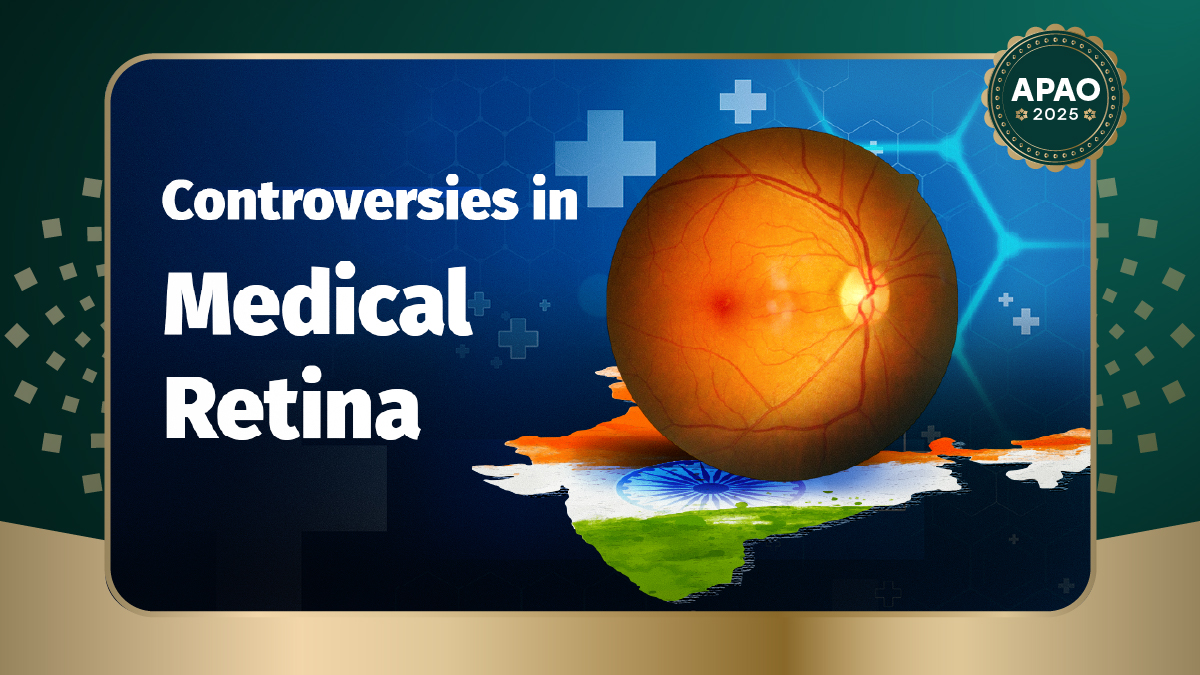Global retinal experts at APAO 2025 in New Delhi, India tackled tough contemporary topics in medical retina, from red light therapy in myopia to bridging the RCT-real world management gap.
The morning of Day One of the 40th Congress of the Asia-Pacific Academy of Ophthalmology (APAO 2025), held in conjunction with the 83rd Annual Conference of the All India Ophthalmological Society (AIOC 2025), dawned by shedding light on some of the hottest topics kicking around the world of medical retina.
A panel of leading specialists from across the globe, including Prof. Timothy Lai (Hong Kong) and Prof. Tan Hock Lim (Singapore), waded into the debate on six thorny topics in the modern medical retina arena. For our first highlight session of APAO 2025, we break down what they had to say here.
Challenges in retinal care delivery in India
What better way to kick off APAO 2025 than an examination of the challenges providing retinal care delivery in the Congress’ host country India?
Dr. Taraprasad Das (India) took to the podium to describe the situation unfolding in India. According to Dr. Das, the barriers to universal, quality retinal care in India can be broken down into four categories: high disease prevalence, and especially diabetes, low human resources for eye health (HReH), unequal distribution of care, especially between wealthy and poor states and urban and rural areas, and the relatively high cost of care.
“This is largely due to a growing, ageing population undergoing lifestyle changes and mass urbanization,” he said.
So how to solve these problems? According to Dr. Das the solutions are more attainable than ever. Task shifting, task sparing, and the use of new technology like artificial intelligence hold the key, he explained, pointing to a program using innovative portable fundus imaging and AI-powered screening in Kerala.
Read More: World-First Comprehensive Government-Backed AI-Powered Eye Screenings Go Live in Kerala
Red light therapy hazards in myopia control
Low-level red light (LRL) therapy for myopia management is cooking on the hot seat, and Dr. Peiquan Zhao (China) stirred the pot even further in his turn at the podium.
He started with the good, citing LRL therapy’s long history of use in China and myriad studies pointing to its efficacy. 1-3
But then it was time for the not-so-good— Dr. Zhao then presented troubling case reports of retinal damage following treatment. “These cases demonstrate the potential evidence of [LRL] to the retina, and need to be taken seriously,” he cautioned.
Dr. Zhao referred to a variety of recent attempts to uncover the reason that LRL therapy can damage the eyes, including choroidal consequences measured in two 2025 studies.4,5
China has responded with regulatory action, but despite these cases, Dr. Zhao remains optimistic.
Read More: JAMA Ophthalmology Viewpoint Examines Impact of China’s Red Light Therapy Regulations
In his conclusion, Dr. Zhao balanced the potential utility of LRL therapy against its risks, calling for more trials studying long-term efficacy, rebound effects and more : “We should be the first ones to increase new technology,” he said, “but also we should be the first to be hesitant about the side effects.”
RCT results vs. real-world management
Getting to the bottom of the gap between randomized clinical trial (RCT) results and real-world outcomes in anti-VEGF therapy for neovascular AMD (nAMD) formed the focus of Prof. Tock Han Lim’s (Singapore) presentation. “We’ve all seen [RCT] visual acuity curves,” he said. “We’ve seen these curves, but we all know the real-world picture is not as rosy. Why so?”
Issues in varying diagnoses and result variance with subtypes like polypoidal choroidal vasculopathy (PCV), a topic close to home with the higher rates of the disease observed in Asia, represent one barrier to achieving RCT-level results in the real world.
The others are similarly familiar to ophthalmologists in the front line of the fight against nAMD: patient adherence and the difficulties in sustaining functional and anatomical gains over the long term.
“You may get very good results in the first 2 years [of treatment], but study after study has shown that vision starts to drop back to baseline and then goes into negative territory beyond four years,” Prof. Lim said.
So are there solutions?
Despite these obstacles, Prof. Lim remains optimistic. Accurate diagnoses using sophisticated, modern tools and appropriate subtyping are at the top of the list. But chief among the tools we can use to bridge the gap is decidedly more old fashioned. “If you can hold on to a patient by establishing good rapport, I think we can overcome many of these challenges,” he said.
Non-exudative choroidal neovascularization
Speaking of subtyping, Prof. Timothy Lai (Hong Kong) addressed the emerging recognition of non-exudative choroidal neovascularization (neCNV) as distinct from traditional wet AMD in his talk.
Prof. Lai structured his talk around a series of controversies surrounding the disease, starting with whether neCNV is even a distinct disease entity (it is, according to the CONAN study).6
Prof. Lai continued by discussing the pathophysiology of neCNV, proper diagnosis (key point: fluorescein angiography is not the way to go), treatment approaches and future directions in neCNV treatment, but his conclusion emphasized one key point: monitoring for and identifying exudation when it occurs is critical.
To do this, Prof. Lai encouraged the use of multimodal imaging, including indocyanine green angiography (ICGA), optical coherence tomography (OCT) and OCT angiography. Beginning with anti-VEGF the moment signs of exudation occur is the best step, and artificial intelligence will be key in predicting early activation of neCNV lesions.
Adaptive optics insights in albinism
Just like with neCNV, advanced imaging technology is revolutionizing our understanding of albinism, according to Dr. Joseph Carroll (United States). His presentation challenged conventional wisdom on the topic.
“Despite having severe pigment deficits, patients with albinism can have foveal morphology and cone specialization that overlap with what’s seen in normally pigmented individuals,” he said, noting that additional data supported at least partially independent developmental mechanisms underlying pit formation and cone specialization.
This wasn’t the only surprising finding his research unveiled.
Dr. Carroll’s research team used adaptive optics to deliver visual stimuli directly to the retina, and the results revealed a surprising parallel. “Individuals with albinism have AO-corrected visual acuity values that are below that predicted by spacing in their foveal cones,” he said, noting a parallel with a patient with foveal hypoplasia and a history of premature birth.
In a sense, Dr. Carroll’s session highlighted the key theme of the session—in monitoring for, treating and managing patients, retinal specialists face complex trade-offs that are increasing as new imaging and treatment modalities become available. As retinal care advances rapidly, these controversies underscore the delicate balance between innovation and patient safety—a tension likely to define the field for years to come.
Editor’s Note: Reporting for this story took place during the 40th Congress of the Asia-Pacific Academy of Ophthalmology (APAO 2025), being held in conjunction with the 83rd Annual Conference of the All India Ophthalmological Society (AIOC 2025) from 3-6 April in New Delhi, India.
References
- Jiang Y, Zhu Z, Tan X, et al. Effect of Repeated Low-Level Red-Light Therapy for Myopia Control in Children: A Multicenter Randomized Controlled Trial. Ophthalmology. 2022;129(5):509-519.
- He X, Wang J, Zhu Z, et al. Effect of Repeated Low-level Red Light on Myopia Prevention Among Children in China With Premyopia: A Randomized Clinical Trial. JAMA Netw Open. 2023;6(4):e239612.
- Xu Y, Cui L, Kong M, Li Q, Feng X, Feng K, Zhu H, Cui H, Shi C, Zhang J, Zou H. Repeated Low-Level Red Light Therapy for Myopia Control in High Myopia Children and Adolescents: A Randomized Clinical Trial. Ophthalmology. 2024;131(11):1314-1323.
- Xiang K, Wang J, Zhu Z, et al. Changes in choroidal thickness in pre-myopic children after repeated low-level red-light therapy and their role in predicting myopia prevention and controlling myopic shift. Asia Pac J Ophthalmol (Phila). 2025;14(2):100115.
- Jiang Z, Chen S, Wang R, Ma J. Safety of and chorioretinal circulation during repeated low-level red-light therapy for myopic children. Clin Exp Ophthalmol. 2025;53(2):119-132.
- Spaide RF, Jaffe GJ, Sarraf D, et al. Consensus Nomenclature for Reporting Neovascular Age-Related Macular Degeneration Data: Consensus on Neovascular Age-Related Macular Degeneration Nomenclature Study Group. Ophthalmology. 2020;127(5):616-636.



